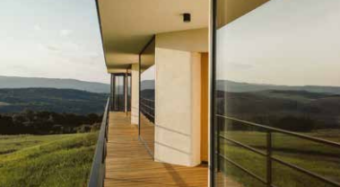
The degradation of the environment has taken green architecture out of its exclusively aesthetic concept, leading it to today’s inevitable need to create a more sustainable future. In Serbia, the concept of green and sustainable architecture is becoming increasingly popular, although many economic and bureaucratic obstacles challenge it, including a lack of support and corruption. We discussed the potential and advantages of this kind of architecture with the architect Ljubica Arsić, the designer of the Hemphouse on the Homolje Mountains. The Hemphouse demonstrated that, through the synergy of dedication, knowledge and love, a person can build a house that will not damage nature, a home to all living beings.
Although it represents a more sustainable way of constructing new buildings, green architecture often requires the demolition of existing buildings. The construction, operation and demolition of buildings are responsible for 40 per cent of global CO2 emissions.
A new, energy-efficient building takes up to 65 years to save the energy lost when the existing building is demolished. Furthermore, what happens to the material when the building’s lifetime is over also poses an issue. One of the biggest trends in sustainable building practice in the West is the concept of the circular economy, which sees waste as a resource and aims to minimize the use of limited resources. In many cases, preserving and renovating existing buildings is more sustainable than demolishing and building new ones. Together with Daniel Fuchs, Ljubica is the co-author of numerous projects. They are currently working on a new project as part of a cooperative called Stadtufer, which bought an old textile factory to transform it into a living, working and cultural space. With this venture, they want to demonstrate how to reuse old structures, adding only sustainable materials and thus reducing the environmental footprint.
IN FOCUS:
- INTELLIGENT ELECTRIFICATION FOR THE INDUSTRY
- PRODUCTIVITY AND A SUSTAINABLE FUTURE THE ABB WAY
- ENVIRONMENTAL PRESERVATION IN LINE WITH PRIORITIES AND STANDARDS
“I have the impression that there is a need in Serbia for a more focused discussion on the potential of adaptation and reconstruction of existing buildings instead of predominantly building new buildings. Many buildings throughout Serbia can be reconstructed. It is a huge job waiting to be done,” Ljubica pointed out.

For urban planning to be truly sustainable, it must incorporate many factors and processes, such as existing facilities, green space, energy-efficient construction, alternative transportation options, and water management systems. By using biodegradable materials, incorporating energy-saving technologies, and fostering community through shared spaces, sustainable homes can be created that contribute to a greener future.
“Together with the Zurich-based company Salewski Nater Kretz, I worked on a project that entailed the development of the eastern part of Bern in Switzerland by the year 2065, in which regenerative agriculture practices are used to structure and manage the landscape that was conquered by removing the existing motorway. The project demonstrates how the collaborative work of architecture, urban planning, landscape architecture, traffic, agriculture, and sociology experts, which were previously mostly considered separate disciplines, creates a new city look,” says Ljubica.
In Serbia, the awareness of the importance of sustainability in architecture is in its infancy because the understanding of issues such as CO2 emissions and their impact on the environment is still limited. Using abstract terms like “climate crisis” or “negative footprint” is not as effective in promoting change compared to using more concrete words like “unhealthy”, which are somehow closer to people.
Prepared by: Katarina Vuinac
Read the story in the new issue of the Energy portal Magazine ENVIRONMENTAL PROTECTION



